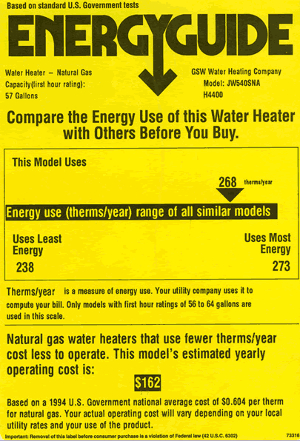Propane group proposes full-fuel cycle analysis to measure heating appliance efficiency
The National Propane Gas Association, among other groups, has been pushing for a full fuel-cycle measure of energy consumption for appliances at the federal level.

|
The Department of Energy sets energy-efficiency standards for appliances in residential and commercial buildings based on site measurements, or at the point of use. These energy-use standards, as well as operating cost information, are printed on yellow EnergyGuide labels (example pictured) attached to many consumer appliances, such as boilers and water heaters.
However, the National Propane Gas Association, among other groups, has been pushing for a full-fuel-cycle (FFC) measure of energy consumption at the federal level — considering the energy consumed in extracting, processing and transporting primary fuels through its point of use.
NPGA argued in its filing with the DOE that of the two types of possible energy consumption measures:
“The FFC analysis is the most accurate way to calculate energy use and environmental emissions because it accounts for (1) Energy consumed in the extraction, processing and transport of primary fuels; (2) Energy losses in electric power-generation or gas processing plants; (3) Energy losses associated with transmission and distribution of fuel to the end user; and (4) Greenhouse gas emissions associated with each step within this process.”
The current standard, called site or point-of-use consumption, reflects only the energy use by an appliance or vehicle at the site where the appliance or vehicle is operated. This type of measurement does not give a realistic portrayal of the energy consumed by a product, such as a water heater, because it fails to take into account energy losses occurring from the generation, transmission and distribution of the fuel to the product, says the NPGA.
For example, under the site consumption standard, an electric storage water heater might operate with 95% efficiency and a propane gas heater with 70% efficiency. However, when the full scope of energy consumed is accounted for in the FFC method, the electric water heater operates at about 24% efficiency compared to the propane heater’s 62% efficiency.
“It’s incumbent on the Department of Energy to inform consumers of the entire energy consumption portfolio of a product, not just the end use,” statedRick Roldan, president and CEO of NPGA. “Water heaters are a great example of how utilizing the FFC method can help consumers make a better informed decision when shopping for energy-efficient and environmentally friendly products.”
The National Academy of Sciences also supports this concept, the NPGA notes. Stating in its final report on a study authorized by the Energy Policy Act of 2005, the NAS concluded, “DOE should consider moving over time to the use of a full-fuel cycle measure of energy consumption for assessment of national and environmental impacts, especially levels of greenhouse gas emissions, and to providing more comprehensive information to the public through labels and other means, such as an enhanced website.”
Also read: FTC Proposes Revised Ranges for Water Heater Boiler Energy Labels
Looking for a reprint of this article?
From high-res PDFs to custom plaques, order your copy today!




